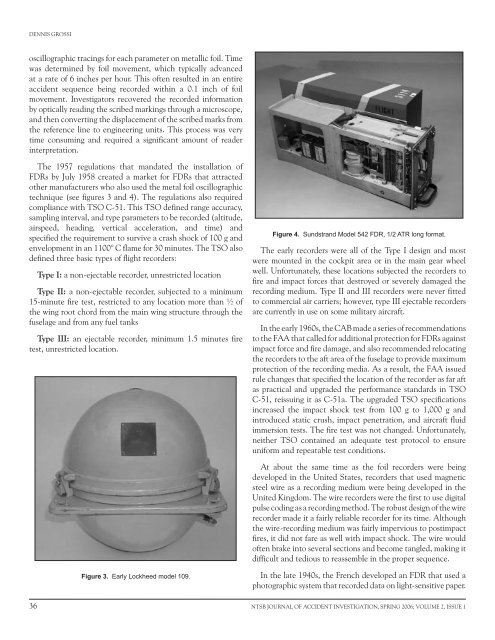Journal of Accident Investigation
Journal of Accident Investigation
Journal of Accident Investigation
You also want an ePaper? Increase the reach of your titles
YUMPU automatically turns print PDFs into web optimized ePapers that Google loves.
DENNIS GROSSI<br />
oscillographic tracings for each parameter on metallic foil. Time<br />
was determined by foil movement, which typically advanced<br />
at a rate <strong>of</strong> 6 inches per hour. This <strong>of</strong>ten resulted in an entire<br />
accident sequence being recorded within a 0.1 inch <strong>of</strong> foil<br />
movement. Investigators recovered the recorded information<br />
by optically reading the scribed markings through a microscope,<br />
and then converting the displacement <strong>of</strong> the scribed marks from<br />
the reference line to engineering units. This process was very<br />
time consuming and required a significant amount <strong>of</strong> reader<br />
interpretation.<br />
The 19 7 regulations that mandated the installation <strong>of</strong><br />
FDRs by July 19 8 created a market for FDRs that attracted<br />
other manufacturers who also used the metal foil oscillographic<br />
technique (see figures 3 and 4). The regulations also required<br />
compliance with TSO C- 1. This TSO defined range accuracy,<br />
sampling interval, and type parameters to be recorded (altitude,<br />
airspeed, heading, vertical acceleration, and time) and<br />
specified the requirement to survive a crash shock <strong>of</strong> 100 g and<br />
envelopment in an 1100° C flame for 30 minutes. The TSO also<br />
defined three basic types <strong>of</strong> flight recorders:<br />
Type I: a non-ejectable recorder, unrestricted location<br />
Type II: a non-ejectable recorder, subjected to a minimum<br />
1 -minute fire test, restricted to any location more than ½ <strong>of</strong><br />
the wing root chord from the main wing structure through the<br />
fuselage and from any fuel tanks<br />
Type III: an ejectable recorder, minimum 1. minutes fire<br />
test, unrestricted location.<br />
Figure 3. Early Lockheed model 109.<br />
Figure 4. Sundstrand Model 542 FDR, 1/2 ATR long format.<br />
The early recorders were all <strong>of</strong> the Type I design and most<br />
were mounted in the cockpit area or in the main gear wheel<br />
well. Unfortunately, these locations subjected the recorders to<br />
fire and impact forces that destroyed or severely damaged the<br />
recording medium. Type II and III recorders were never fitted<br />
to commercial air carriers; however, type III ejectable recorders<br />
are currently in use on some military aircraft.<br />
In the early 1960s, the CAB made a series <strong>of</strong> recommendations<br />
to the FAA that called for additional protection for FDRs against<br />
impact force and fire damage, and also recommended relocating<br />
the recorders to the aft area <strong>of</strong> the fuselage to provide maximum<br />
protection <strong>of</strong> the recording media. As a result, the FAA issued<br />
rule changes that specified the location <strong>of</strong> the recorder as far aft<br />
as practical and upgraded the performance standards in TSO<br />
C- 1, reissuing it as C- 1a. The upgraded TSO specifications<br />
increased the impact shock test from 100 g to 1,000 g and<br />
introduced static crush, impact penetration, and aircraft fluid<br />
immersion tests. The fire test was not changed. Unfortunately,<br />
neither TSO contained an adequate test protocol to ensure<br />
uniform and repeatable test conditions.<br />
At about the same time as the foil recorders were being<br />
developed in the United States, recorders that used magnetic<br />
steel wire as a recording medium were being developed in the<br />
United Kingdom. The wire recorders were the first to use digital<br />
pulse coding as a recording method. The robust design <strong>of</strong> the wire<br />
recorder made it a fairly reliable recorder for its time. Although<br />
the wire-recording medium was fairly impervious to postimpact<br />
fires, it did not fare as well with impact shock. The wire would<br />
<strong>of</strong>ten brake into several sections and become tangled, making it<br />
difficult and tedious to reassemble in the proper sequence.<br />
In the late 1940s, the French developed an FDR that used a<br />
photographic system that recorded data on light-sensitive paper.<br />
36 NTSB JOURNAL OF ACCIDENT INVESTIGATION, SPRING 2006; VOLUME 2, ISSUE 1
















